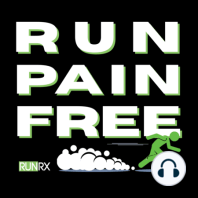10 min listen

Why Do I Feel More Comfortable at a Lower Cadence?
Why Do I Feel More Comfortable at a Lower Cadence?
ratings:
Length:
12 minutes
Released:
Feb 11, 2022
Format:
Podcast episode
Description
Short episode summary In this episode of the RunRX podcast, Coaches Valerie and Caroline share why running at a slower cadence is more comfortable for some people. Tune in now! Timestamps of big takeaways Comfortability at a Lower Cadence and Muscle Elasticity [0:35] Coach Caroline tells us she feels more comfortable at a slower cadence, and Coach Valerie explains she doesn’t have a rule for a certain cadence. However, around 180 cadence gives you the ability to use muscle elasticity. [1:46] When it comes to running, three primary forces are at work: gravity, ground reaction force, and muscle elasticity. These three forces collaborate as a unit. It is not a magical occurrence; it occurs as a result of the ability to pull the foot up at the appropriate time. Comfortable Being on the Ground [2:55] In running, you can either push back your foot or you’re reaching with the front. You will never see a runner with both feet in the air. Something more comfortable necessitates more muscular effort but less cardiovascular effort. Control Freak Mentality [3:44] When Coach Valerie started running, she considered herself a control freak. She believes that if her action can be controlled, she can control her run. Most of the time, in running, the action is seeing how many miles you’re going to run and not how it will be done. Running is free-falling, so you need to be comfortable being uncomfortable. Running is Never Effortless [5:10] Running can be the hardest thing to do, and never effortless. The actual pulling of the foot is not an effort nor work but a challenge. The action here is breathing, holding the shoulders, ear, and hips in line. Thoughts on Not Being Able to Let Go [6:39] Coach Valerie suggested that you pay attention to your breathing and where you are. There is no such thing as falling on a treadmill. As a result, it's one of the best places to work on your upper body posing. Lower the speed if you're having trouble with the lower part of your run on a treadmill. Despite running slowly, a high cadence is still possible. People sometimes get stuck because they want to run faster. Curb Run [8:09] Coach Caroline shared her experience during a curb run with Coach Valerie. They did a curb run for 4 minutes and it was challenging. However, they concluded that it wasn’t about speed, falling, or 180 cadences. [9:39] Curb run is a strength and elasticity exercise. It is important to think about moving your feet at a pace that you need to run at. It’s not the lack of fitness but a lack of understanding of how to use your muscle elasticity. [10:30] The main thing to remember about those curb runs is to keep your ears, shoulders, and hips in line. This leads to improved running and fall control, and it is one of the challenges faced, particularly by new runners. Rate, Review & Subscribe Reminder Don’t forget to like and subscribe to our show. You can also rate and review our show on iTunes! We’re on Spotify as well, or you can listen to our show directly on Libsyn here. Links mentioned in episode -- Join the membership: https://runrx.fit/join-runrxstrong/ -- https://www.runrx.fit/ -- Have questions? Email us at support@runrx.fit -- Follow us on Facebook https://www.facebook.com/runrxfit/ and Instagram https://www.instagram.com/runrx/
Released:
Feb 11, 2022
Format:
Podcast episode
Titles in the series (100)
Should You Run with an Injury?: Short episode summary Can you run with an injury? In this episode, Coach Valerie talks about her sprained ankle injury, what you should do if you have an injury, and whether or not it’s okay to run while injured. Timestamps of big takeaways... by The RunRX Podcast